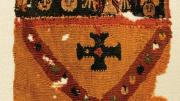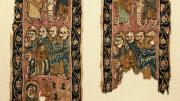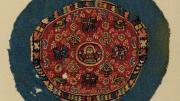How can one understand people, and a civilization, who perished centuries ago? The jewelry and textiles they wore “are some of the most intimate objects to survive,” observes Elizabeth Dospěl Williams. “We can relate to them today. We understand immediately how they function. It closes the gap of time.”
And gorgeously so, in “Ornament: Fragments of Byzantine Fashion,” drawn from the Dumbarton Oaks collection of Egyptian funerary textiles from the fourth to the fourteenth centuries, on display through January 5. Assistant curator Williams co-organized the exhibition, and a concurrent one on household textiles (at George Washington University’s Textile Museum), with Gudrun Bühl, director of the Museum für Lackkunst, Münster. This first exhibition of one-quarter of the D.O. collection had to overcome not only the frailty of the materials, but formidable obstacles to understanding. Williams has devoted the past seven years to cataloging the holdings, organizing this display (postgraduate fellow Samuel Shapiro ’18 assisted), and creating the dazzling online version invaluable to scholars and the curious alike (www.doaks.org/resources/textiles).
As the samples shown here attest, “the Sunday best of the deceased,” as she puts it, survived burial suprisingly well, the plain-woven linen backgrounds and tapestry-woven woolen details intact. Then they were discovered, largely in nineteenth-century excavations, and—like the illuminated manuscripts torn apart by book “breakers” to sell the prized bits—were cut up by dealers. (A dealer’s album, with specimens, is on loan from the Metropolitan Museum of Art.) “Tons of context are lost,” Williams laments. But the surviving fragments are “categorically beautiful.”
The tunic clavi (the decorative vertical bands above at left) depict multiple figures, in beige, red, light green, light blue, blue, dark blue, purple, several shades of tan, and brown—a dazzling rainbow of dyes (not yet analyzed, but mostly derived from plant sources). The rectangular tunic fragment (above) depicts faces and vegetal patterns beneath a border, perhaps of gemstones; more gems descend to a pendant face, and frame a gem-studded cross. The intricate medallion (left) surrounds a human bust with geometrical shapes, vegetal motifs, and indeterminate quadrupeds.
A few complete tunics, and replicas, are on display, including a toddler-sized one. Unlike architectural antiquities, these are “human-sized,” Williams says. “We connect immediately to the people of the past”—as she, with two young children, connects to the unknown wearer of that tiny tunic from ages ago.











